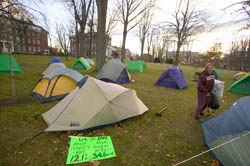Bates alum's documentary to be shown
A Bates College graduate’s documentary about a citizen response to a controversial construction proposal in Lewiston will be screened at 7 p.m. Wednesday, March 25, in Bates College’s Pettengill Hall, Keck Classroom (G52), 4 Andrews Road (Alumni Walk).
Presented by the Harward Center for Community Partnerships at Bates, the screening of “Neighbor by Neighbor: Mobilizing an Invisible Community in Lewiston, Maine” is open to the public at no cost. For more information, please call 207-786-6202.
Created by Craig Saddlemire, a Lewiston resident and member of the Bates class of 2005, the film follows the response to the 2004 Heritage Initiative, the city of Lewiston’s plan to build a four-lane boulevard through a low-income downtown neighborhood. The project would have displaced 850 residents and destroyed playgrounds, vegetable gardens and historic buildings.
Residents of the neighborhood, supported by Bates student organizations, organized the Visible Community Initiative and halted the construction project.
Saddlemire became involved with the project when members of the Visible Community wanted raw video footage to serve as a record of the group.
The film documents a significant period in Lewiston’s history, depicting how the town dealt with urban revitalization during a depressed economy. It provides not only a record of the work of the Visible Community, but also a visual chronicle of changes in the neighborhood through the past five years.
“Once I started videotaping for the group, I never stopped,” says Saddlemire, who now has his own film production company, Round Point Movies. “This movie documents how hard some of the residents downtown have worked to make good lives for themselves in this neighborhood, and how much a misguided development plan can affect their lives.”
After his senior year at Bates, Saddlemire settled in downtown Lewiston and took a more active role in the initiative. The idea for a documentary developed when the Visible Community applied for a grant from the Self-Development of People Fund to develop a master plan for downtown Lewiston, created by the residents.
The group used grant money to document the planning process and edit other footage into a comprehensive history of the work the Visible Community had done.
After the Heritage Initiative was defeated, the organization lobbied to replace a closed city park, held demonstrations and eventually authored its own master plan for downtown Lewiston.
“Through the film, current students will be able to see how Bates students played a supportive role to the downtown residents, who in turn really impacted the Bates students that were involved,” says Saddlemire. The Visible Community, he says, effectively brought town and gown closer.
“The film demonstrates that there’s a lot to learn about the world beyond academia, and you can do that by just stepping off campus,” says Saddlemire. “People have misconceptions about downtown Lewiston, and I think seeing the people in this film tell their story will make people who hold those misperceptions think twice.”
The Harward Center for Community Partnerships leads Bates’ efforts in community involvement, including programs in service-learning, community volunteerism and environmental stewardship. The center works with community partners to meet community needs and, in the process, to integrate civic engagement with the Bates educational experience.




